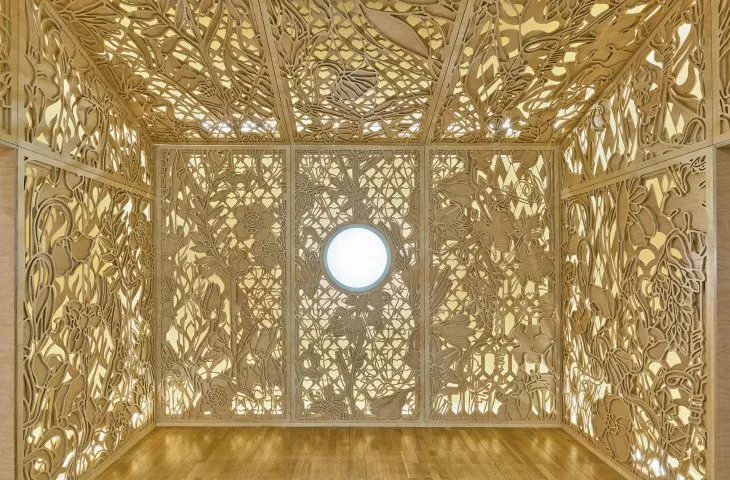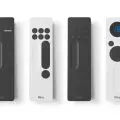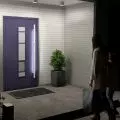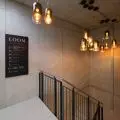Interview with Bartosz Haduch of NArchiTEKTURA studio
[original material A&B 7/8'2019]
Bartosz Haduch is the founder of NArchitekTURA studio. He is originally from Gliwice, but works and lives in Krakow. The studio works based on the synergy of architecture with nature and art. This combination results in buildings, parks, but also books, furniture or art photographs appreciated in prestigious competitions. Bartosz Haduch is interviewed by Malgorzata Tomczak about work, design and inspiration.
Bartosz Haduch
Photo: © archives of the architect
Malgorzata Tomczak: Bartosz, tell us about the concept of this issue? What did you want to show, how and why?
Bartosz Haduch: I used to think quite seriously about working in the editorial department of an architectural magazine, so thank you for making it possible for me to realize this dream. In the few dozen pages I was given, I wanted to show and describe a substitute for a rather subjective interpretation of what I think beauty is - in architecture, art and nature. This issue is an opportunity to share my interests, passions, fascinations, but also different forms of activity - from journalism, graphic design and photography, to architecture and design. This publication is also an excuse to invite people I value and who inspire me (some of them are making their debut in the pages of A&B as writers). This issue is such an intellectual and visual journey around the world, with me as the guide. [Laughs]
Bartosz Haduch, Michal Haduch "architectourism 01. SPAIN"
Malgorzata: Staying still on the subject of editing and publishing, let's talk for a moment about books, too, perhaps. You have published several of them. Apart from the fact that for the reader they were inspiring excursions into the world of particular architects or countries - as in the case of "Architectourism" dedicated to the contemporary architecture of Spain - you always took great care of their visual value. In fact, you built this issue in a similar way. Besides the fact that you wanted to show those themes in architecture that move you the most, you said, among other things: "I want this publication to also bring a kind of holiday respite to the reader, without an excess of pathos, scientism and technical information, so that page after page they simply look at beautiful architecture and art."
Bartosz: Indeed, I treated the current issue of A&B as if it were the next book, taking care of the selection and order of topics, the layout of the material, the selection of illustrations or photos. You yourself witnessed how, together with A&B's art director Lubomir Nikolov, we chiseled every detail of the publication for several weeks. We turned the magazine's existing composition and graphics upside down (but don't worry - it's just a one-time revolution). [Laughs]
Together with Lukasz Marjanski, we also designed a custom cover and even a font that we liked so much that I think it will appear in the new NArchitekTURA logo. This outer wrapper, by the way, has a hidden section with an art piece called "micro/macro cosmos," in which we used the famous photo taken in 1972 by the Apollo 17 crew. Photography and art, by the way, are the leitmotifs of this issue. At a time of an overabundance of images and a certain oversaturation associated with today's technological and Internet visual culture, I wanted to perversely show illustrations that are precisely selected, carefully composed, showing places that are special to me. Real, not virtual. Most of the photos published in this issue are of my authorship, so for me it is also a kind of "photographic diary", evoking specific impressions and memories. The presented materials can also inspire further exploration, research and travel, as in fact each topic would deserve a separate publication and could successfully fill an entire magazine. Besides, I believe that architecture can only be deeply known and felt through empirical experience.
Cover of A&B issue 7-8/2019, proj.: NArchitekTURA
Margaret: You also prepared most of the texts for this issue. They vary in subject matter, length and even style. Tell us about the process of their creation and how and why you write.
Bartosz: The four texts are about books I have worked on over the past decade, so they necessarily differ somewhat. The monograph "Herzog & de Meuron. Architects (and) Artists" was based on my doctoral dissertation, and I am currently thinking about updating it and publishing a second, expanded edition. On the occasion of the holiday issue of A&B, I present brand-new photos of the realizations of these Swiss architects, as well as the fascinating story of the Kramlich family's residence and art gallery, whose design captivated me while I was still a student. The latest book - "Jean Nouvel. Ar(t)chitecture" is actually already assembled and awaiting publication at the end of 2019. The essay "Teshima's Windows," in turn, is a preview of the monograph "SANAA - Kazuyo Sejima + Ryūe Nishizawa," which I am currently working on. The seed for this publication was a series of photographs from the Teshima Art Museum, and one of them is special to me - it won a prestigious award in the international Sony World Photography Awards and is the only "painting" hanging on the wall in my house.
However, the adventure of writing and later publishing books began much earlier - in 2011. The first one - "Architectourism 01 - Spain". - I prepared together with my brother Michael. We have been writing together for many years, and it is a kind of perfect synergy of two slightly different, but perfectly complementary personalities. For a long time we were Polish correspondents of the bimonthly magazine "MARK Magazine", we also published in "Wallpaper", "Domus" and most Polish magazines about architecture and design. Collective work on the books gives us the opportunity to have full control over the material - from text to graphics, which is why we are increasingly publishing them only in limited editions, on our own. They are mostly illustrated with our photos and are a kind of chronicle of our many travels. And for me, writing itself is probably one of the fastest and most direct forms of expression and capturing thoughts. More precise than speech, material - unlike music, less pictorial than photography or film, not as tangible as architecture. The word lies at the heart of most creative activities.
Ethnographic Museum in Cracow, 2008-2009, proj.: NArchitekTURA - Bartosz Haduch, Sebastian Machaj, Jakub Wagner, Piotr Wroczek
photo: Dominik Papaj
Malgorzata: Quite a lot of your work is a search for connections between architecture and art. You even wanted to study painting, but ultimately chose architecture. This is also a very interesting thread in your design history. You smuggle a bit of art into each of your projects. Whether it's in the Ethnographic Museum in Cracow, the Oświęcim realization of "Oshpitzin," or in the design of the Wyspianski exhibition at the National Museum.
Bartosz: While working on this issue, I even dug up my old paintings and experienced quite a surprise. Maybe I won't reveal whether it was positive or negative. [Laughs] After those first youthful artistic attempts, a fascination with photography emerged. At that time I studied piano and guitar for several years. So art had been present in my life for a long time, and architecture seemed a very capacious medium within which to combine different interests and passions.
Indeed, most of NArchitekTURY's projects manage to smuggle in various artistic themes. The Ethnographic Museum in Cracow featured coded musical notations, the Contemplatorium at the Benedictine Abbey in Tyniec referred to historical antiphonaries, the French confectionery Nad & Greg featured discreet graphic interventions bordering on op-art. At the Continuum House and the Jewish Museum in Auschwitz, in turn, we experimented with prototype materials. I tested the effect of the sanded oxidized sheet metal from the latter project with my own hands for over six months! Sometimes we confront directly the work of prominent artists. Having completed two monographic exhibitions of Stanislaw Wyspianski, we are currently working on a major exhibition of Hokusai Katsushika. At other times, we ourselves invite artists to create site-specific works as part of our realizations. This was the case with the Future Apartment in Dobrodin.
Art is an integral part of more than just my professional life. I try to keep up to date with what's new in the art world. I am interested in the history of art, I see a lot of exhibitions, I travel along the trails of selected masterpieces - historical and contemporary, I collect albums, biographies and monographs of selected artists. I greatly appreciate artists such as Hiroshi Sugimoto, James Turrell, Richard Serra, Gerhard Richter, Olafur Eliasson and Anish Kapoor, and this issue of A&B is a kind of tribute to their work.
Exhibition "Wyspianski", National Museum in Krakow, 2016-2017, design: NArchitekTURA - Bartosz Haduch, Łukasz Marjański, Michał Haduch; Graphics: Free3 - Paulina Suchińska, Bartłomiej Suski
Photo: Jakub Certowicz
Małgorzata: Now perhaps a moment for Wyspianski. We already discussed the exhibition project at the National Museum in Krakow in the October issue [cf. A&B 10/2018]. However, you did not say in it what dialogue you had with Wyspianski? What from the art of this Young Poland artist do you think is still relevant and interesting for today's audience?
Bartosz: Speaking of dialogue, continuing the theatrical-film nomenclature, as designers we tried to play a supporting role well, giving the foreground to Wyspianski's multidisciplinary work. We wanted to create a background that was closer to contextuality, uniqueness and memorability than to neutrality. We wanted to create a narrative based on a gradation of impressions, where intimate spaces related to the artist's private life were mixed with monumental halls dedicated to his works for sacred interiors. I admire Wyspianski's work for its richness, multidimensionality and timelessness. I am impressed by the courage with which he faced the great, difficult, ultimate themes.... I am touched by the tenderness and caring in his way of portraying his loved ones - his wife, his children, his few friends. Touching is perhaps the most beautiful emotion art can evoke.
The exhibition "Wyspiański. Unknown", National Museum in Krakow, 2018-2019, proj.: NArchitekTURA - Bartosz Haduch, Łukasz Marjański, Michał Haduch
photo: Bartosz Cygan
Malgorzata: You approached the Wyspianski exhibition twice. The second project was the library, which could be seen as part of the exhibition in its final months. The two rooms - blue and yellow, the obtuse shapes. How much of this project, in turn, is Wyspianski himself, and how much is your interpretation of his work?
Bartosz: The library within the exhibition "Wyspianski. Unknown" was meant to be a spatial extension of the stained glass project "Apollo (Copernicus System)" from 1904, the dominant feature of the exhibition. Standing in the center of the designed interior, one can see that the rounded lines of the black bookcases are, so to speak, a continuation of the orbits drawn by Wyspianski on the famous pastel. Also the colors - blue and yellow - are directly taken from this masterpiece. I hope that both in this space and as part of the entire Wyspianski exhibition we have managed to create a kind of adequate dialogue between architecture and art, as well as past and present. And coming back to the last question - in my work (and life too, I guess) I try to avoid obvious quotes and unambiguous, unquestionable definitions. Every NArchitekTURY project is a composite of many factors - ideas, context, time, inspiration, experience, investors, users, budgets, etc., and the ways in which they are combined and interpreted always vary, juggling somewhere between intellectual rigor and intuitive spontaneity.
Oshpitzin Jewish Center, Oświęcim, 2013-2015, proj.: NArchitekTURA - Bartosz Haduch, Łukasz Marjański; Imaginga Studio - Magdalena Poprawska
photo: Jakub Certowicz
Malgorzata: You are also approaching the subject of the Jewish Museum in Oswiecim for the second time. First there was the exhibition, now there is the park.
Bartosz: In the beginning, we were supposed to plan only an additional display as a continuation of the "Oshpitzin" permanent exhibition project, which was completed earlier. These distinctive triangular prisms had already appeared in the museum's interiors, another one was installed in a public space - in Skarbek Square, and the new one was to be built on the site of the Great Synagogue (1863-1939), destroyed during the war, which is now overgrown with dense vegetation. When we first saw this beautiful meadow surrounded by wild trees, we asked the investors: why don't we design this entire space instead of a single display? That's how it started, and now we are impatiently waiting for the start of construction of the Memorial Park in the heart of Auschwitz.
References to the defunct architecture of the former synagogue appear in various forms in the new design. The projection of the synagogue is marked in the floor and it separates the interior of the park from the surrounding dense greenery. The entire establishment opens up to a picturesque panorama of the boulevards around the Soła River. The main element of the park's development is forty stone slabs arranged in a free composition of the floor. Their irregular arrangement is meant to symbolize the ruins - the remains of the former synagogue. The mosaic of gray sandstone slabs leads to specific elements of the urban interior: the display (the one that was the nucleus of the entire establishment), a well with a historic floor, a water pond, benches and a chandelier (which is a copy of an artifact found at the site during archaeological excavations). The dimensions, numbers and shapes of the forms used have a symbolic meaning and refer to selected themes drawn from Jewish tradition and culture.
Cukiernia Nad & Greg, Krakow, 2016, proj.: NArchitekTURA - Bartosz Haduch, Łukasz Marjański, Michał Haduch; graphic design: Free3 - Paulina Suchinska, Bartłomiej Suski
Photo: Jakub Certowicz
Malgorzata: You also conduct teaching activities. In Poland, somehow it's arranged so that in architecture faculties, architects without professional practice or with little experience usually teach (although this is not the rule, of course). You try to combine the two. How does academic activity translate into design activity in your case? Or is it the other way around?
Bartosz: Just where I teach - at the Faculty of Architecture and Fine Arts of the Andrzej Frycz Modrzewski Krakow Academy - there are mainly practicing designers, with impressive achievements and thriving offices. I think it's an inspiring creative environment, both for students and instructors. The university provides an opportunity to pursue research projects related to my interests, as well as trips abroad as part of international cooperation. While still in college, I took advantage of the Erasmus program and now, years later, I recommend it to all students. I think it's the best school for the future profession, but most of all for life. [Laughs]
As for the didactic process itself, I always try to go beyond the so-called minimum curriculum - not only to teach architecture, but also to inspire, encourage participation in competitions, broaden horizons to other fields of science, stimulate openness and curiosity about the world, increase environmental responsibility, etc. I am sure that within the framework of a student-teacher meeting, each party can learn something. Of course, teaching and research work also influences my project activities. A few years ago I had the opportunity to combine science and practice in the realization of the Apartment of the Future, which can be regarded as a kind of hybrid of apartment, showroom, hotel room, art gallery, but also a laboratory. Renowned companies were invited to the project, testing the latest solutions and products in this interior. In cooperation with scientific institutions, the interior also conducts research related to the development of residential spaces, design or aesthetics, as well as trend creation, behaviorism, sociology, ergonomics and ecology.
Apartment of the Future - R&D Laboratory, Dobrodzień, 2011-2015, proj.: NArchitekTURA - Bartosz Haduch, Łukasz Marjański, Rafał Mikulski, Michał Sapeta, Bartosz Dendura, Michał Haduch
Photo: Jakub Certowicz
Margaret: NArchitekTURA is celebrating its tenth anniversary. Such an anniversary is a time for summing up, and probably also for reflection. You have achieved a lot, you have designed, built, participated in competitions, published beautiful books about architecture, traveled a lot. Ten years was also the time when you matured as an architect. What was that process like?
Bartosz: It's difficult to answer in the past tense, because it's an ongoing process. It's also difficult to talk about the future tense, because mostly I prefer to focus on the here, now, possibly tomorrow. I'm fortunate that I do what I like to do in life, so I try to do it as well as I can. Somehow I manage to pursue this vision of work-passion fairly uncompromisingly, selectively and in multiple ways, without losing sight of the ideals. Of course, the creative process itself is most often collective and connected with specific people, and the core of NArchitekTURA has been unchanged for many years. With Lukasz Marjanski we create architecture, with Michal Sapeta we create graphics, and with my brother we write articles and books. They are trusted, hardworking and extremely talented people with whom we understand each other without words. However, it is not for me to judge the value and significance of the results of our work.
Margaret: Would you reveal what NArchitekTURA's immediate plans are?
Bartosz: Resting after hard work on the holiday issue of A&B. [Laughs]
Margaret: Thank you for the interview!






























































